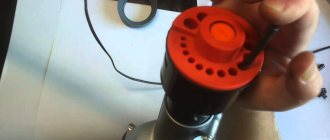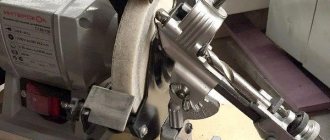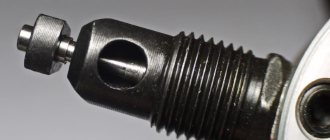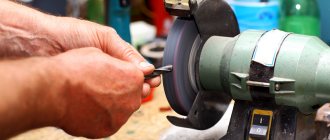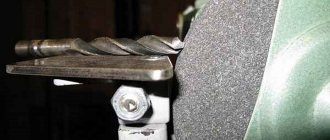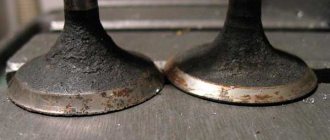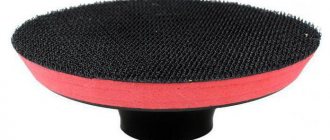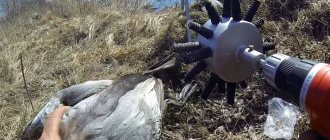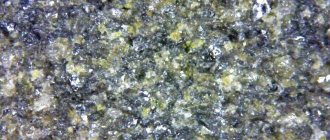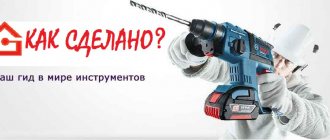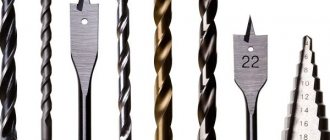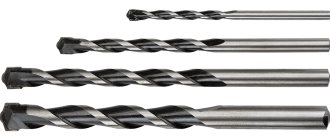Drills become dull quickly, and buying new ones each time is quite expensive. If you know a craftsman with a sharpening wheel, the problem can be easily solved, but not everyone is so lucky. To get your tools in order yourself, there is a special sharpening device - a drill attachment for sharpening drills, which is driven by the drill.
What is a drill attachment for sharpening drills?
It looks simple - a small device in a plastic case, inside of which a small grinding wheel rotates. It is installed in such a way that it creates an angle with the cutting edge at which sharpening of drills becomes possible.
There are holes along the body, the dimensions of each of them correspond to a certain diameter of the drill. Using a standard attachment, you can sharpen drills with diameters from 3.5 to 10 mm. The holes are arranged so that the drill comes into contact with the circle at the desired angle. The cutting edges are sharpened one by one, the second is sharpened after turning by 1,800. The drill attachment itself for sharpening drills is attached to the drill using a coupling. In this case, the chuck jaws close completely.
Advantages and disadvantages
Main disadvantages:
• Fragility, which is understandable, especially if you sharpen thoroughly dull edges. It is preferable to use it to straighten slightly sagging drills. • Weak fixation on the drill itself • Inability to change the parameters of the attachment itself - the sharpening angle does not change (changing the location of the sharpening stone on your own is a rather difficult process) • The coupling does not always fit the chuck; in this case, when rotating, it comes into contact with its inner surface. If possible, before purchasing, you should try on an attachment on a drill of the same class as the existing one. • You will have to immediately buy a bracket for fixing the drill. Otherwise, sharpening will be uncomfortable - holding the drill and turning the drill is inconvenient
Despite these shortcomings and inconveniences that arise when using the attachment, it is a fairly popular addition to the home craftsmen's toolkit. Especially when you consider that you can learn how to sharpen drills on the first try, and trips to the store for them will become much less frequent.
Distinctive design features and principle of operation
The structure of attachments for electric drills, specializing in sharpening drills, includes a plastic shell, inside of which there is a rotating sharpening wheel. This is a surface of a specialized shape that creates the necessary sharpening angles on the working elements of cutting tools.
Most of the newest models of attachments for electric drills for sharpening tools are equipped with an end cap on the casing, on which there are holes. The diameter of each of them is proportional to the specific drill size.
Drill sharpening, carried out using a similar attachment, occurs in the following way:
- The drill, the cutting area of which is to be threaded, is inserted into a hole in the nozzle casing, which has a suitable diameter.
- The electric drill starts to work, as a result of which the sharpening stone begins to spin. One side of the working surface of the drill is sharpened.
- The drill is rotated 180 degrees in the nozzle hole, and the other cutting edge is sharpened.
There are also simpler options - without an end cap. They are more primitive than a conventional device, but they are extremely uncomfortable to use. It is necessary to carefully monitor the correct location of the sharpening surface and the cutting edge of the drill.
Such a sharpener for drills for an electric drill can also have a much more unpretentious design, where neither the presence of a cover nor the technological holes that serve as a jig are provided. It is very difficult to practice such attachments; they are uncomfortable for the reason that it is necessary to hold the sharpened drill in the correct position. Additionally, proper angles must be maintained on the cutting part.
Features of working with the tool
A feature of the standard attachment is that the holes for the drills are made so that the edges are next to the grinding wheel at a certain angle. There are also simplified options - without a regulating cover. They are simpler than a standard device, but they are not very convenient to use. You have to constantly monitor the correct position of the cutting edge and sharpening surface.
Anyone who has a drill at home can do the job of sharpening drills. The operating algorithm is simple and does not require any special skills:
• the drill is inserted into a hole corresponding to its diameter • after turning on the drill, the emery sharpening wheel begins to rotate, in the process one edge of the drill is sharpened • to sharpen the second cutting edge it must be rotated in the hole by 1,800
The drill is checked for readiness; if necessary, the sharpening process is repeated several times.
Design features
The design of the nozzle for sharpening drills includes a plastic body, inside of which an emery wheel with a specially shaped working surface rotates, which allows the desired angle to be formed on the working part of the tool. The emery wheel rotates thanks to a drill, the shaft of which is connected to the device using a special coupling.
Most modern models have an end cap on the body with holes of different diameters in it, designed to sharpen drills of different sizes. The holes are made in such a way that the tool, whose working part is inserted into them for sharpening, touches the emery wheel only in a certain position.
Sharpening is done like this:
- The drill, whose cutting part needs to be sharpened, is inserted into a hole of the proper diameter in the nozzle body.
- The drill turns on, the emery wheel begins to rotate, and one half of the cutting part of the drill is sharpened.
- In the hole of the nozzle, the tool is rotated 180°, and the second cutting edge is sharpened.
This procedure is carried out until the required parameters of the cutting part are achieved.
The sharpening device, which is mounted on an electric drill, can be of a simpler design, in which there is no cover with holes that acts as a conductor. Devices of this design are inconvenient, since it is necessary to hold the tool being processed by weight and always monitor the correct sharpening. The drill attachment used for sharpening can be made with your own hands. In design, homemade nozzles are not much different from factory-made analogues. Typically, the following elements are present:
- Frame.
- A mounting ring or coupling for connecting to a drill chuck and imparting torque to the working part of the device.
- An emery wheel whose working surface must be shaped into a cone shape on a lathe.
- Emery wheel attachments.
- The top cover plays the role of a conductor, which ensures convenience and correct sharpening.
In addition to attachments for sharpening drills, the market offers devices designed to restore the geometric parameters of the cutting parts of other tools, in particular: attachments for sharpening circular saws, chisels, plane knives and other similar tools.
How to choose the right one, scope of application
The average cost of a sharpening device is no more than a thousand rubles. As mentioned above, before purchasing, you should check the compatibility of the purchased device with the drill for which it is purchased. At the very least, you should measure the bore diameter in advance, but it is better to check directly on the tool. The store will probably have a drill model similar to the one you have.
Some accessory models come with spare grinding wheels. This is convenient and will extend the life of the nozzle. When using the attachment, you should remember that this is not a professional sharpening machine. Initially, this prefabricated structure is not designed for heavy loads.
There are three types of nozzles:
• for circular saws • for drills • for plane and chisel blades
The demand for such attachments is not a random phenomenon. Professional sharpening by craftsmen with special tools is quite expensive, and the presence in the house of such additions to the drill, which everyone has, ensures the ideal condition of all cutting surfaces and edges.
The attachment should be selected in accordance with the drill model. You can pay attention to devices from well-known companies. Many power tool manufacturers produce similar devices that are ideal not only for their products, but also for drills from other companies. The best option is when the attachment comes with the drill itself. Before purchasing, you need to decide on the type of sharpening required and the diameters of the drills that are most often used, so that the use of the attachment is as effective as possible.
Selection criteria and application
The first thing you pay attention to when choosing is the compatibility of the diameter of the mounting hole in the coupling and the diameter of the drill chuck on which it will be mounted. The sharpening angle of the tool that this device provides is also important.
Many manufacturers of bits include a sharpening stone in the kit, with which drills can be sharpened at a different angle. To increase the functionality of the device, it is better to choose a model with an additional sharpening stone.
You should not overload the device if you want it to last longer. The attachment is indispensable in a small home workshop, where an emery machine is not always available.
Accessories, spare parts
The best option to buy is an attachment with spare sharpening stones. If possible, you should purchase a bracket for fixing the drill - this will greatly facilitate the task, especially if sharpening will be done regularly. Each device comes with instructions that will make it easier to learn the new function of the tool. A regular grinding wheel is designed for several dozen operating cycles, so you can calculate the expected load and buy components according to plan.
Choosing a drill attachment for sharpening drills
- Distinctive design features and principle of operation
- Pros and cons of use
- How to choose wisely. Areas of use
- Parts for assembly, spare parts
- Reviews
- Summarize
With frequent use of drills, there is a need to sharpen them.
The modern market provides various devices to accomplish this task. However, few people know that today you can sharpen a drill using an ordinary electric drill. This is achieved thanks to all kinds of attachments and attachments, which make it possible to create a multi-purpose device from a drilling machine. One of these devices is an attachment for an electric drill for sharpening drills, which, in the absence of emery and a sharpening stone, makes it possible to correct the shape of the drill and restore its functional properties.
Specifics of sharpening with different cutting edge shapes
There are 4 types of edge, they need 2 different approaches:
- single-plane and two-plane are processed by approaching the planes (alternately) with an abrasive wheel; there is no need to move the tool;
- cylindrical and conical ones undergo a slightly more complicated procedure - the working part is also brought to the moving abrasive, but with one hand the master presses on it, and with the other he holds the edge and rocks it from side to side to achieve uniform grinding.
Errors and their prevention when working with emery for sharpening drills
Mistakes are often made:
- Different edge lengths. Leads to their breakdown. You can avoid this with an accurate eye and measurement before starting work.
- Asymmetrical angles. The result obtained is the actual exploitation of only one edge. Solution - review the drawings, perhaps your holder is not very functional, its tilt will lead to asymmetry.
DIY nozzle
If we are talking about some rough and rough work, then it is quite possible to get by with a homemade device. One of the easiest ways is to remake a classic round file. It is enough to remove the handle from the tool and process the seat so that it fits tightly into the chamber and is securely held.
To make a rough disk attachment, you will need a piece of plywood, a pin and a bolt with threads on both ends. Sandpaper will be used as a grinding wheel. We cut a circle out of plywood, attach a pin to it and glue sandpaper on top. After abrasion, you don’t have to remove the latter, but simply stick a new sheet on top.
Tools for sharpening drills
Nozzle Bosch S41
Serves to successfully sharpen drills of different diameters. It is intended for a drill with a spindle diameter of 43 mm.
The attachment makes it possible to straighten drills that have become dull during operation.
Options:
- The sharpening angle is 118°.
- Optimal spindle speed is 2-3 thousand rpm.
- The diameter of the sharpened drills is 2.5-10 mm.
The Bosch S41 drill sharpener, like any tool from this brand, has no complaints. There are practically no complaints.
Consumer reviews:
I purchased this attachment before I was improving my garage. To be honest, I came to the construction market with one single purpose - to buy a small sandpaper. And when I saw this device, I asked the seller if it was worth buying. He replied that people take it and no one has returned it yet.
I was also attracted by the reasonable price. I don’t regret the purchase: I saved money and, thanks to this attachment, I did everything as I planned. That's what Bosch means! He is beyond competition!
Igor
I purchased this sharpener. Sharpens with a bang. I rarely drill, so it will last me a long time. Bosch, as always, is at its best: beautiful appearance, pleasant to hold. And, of course, it works great. The money was not in vain.
Alexei
Nozzle KWB 5032−00
Exists for sharpening HSS twist drills.
Options:
- The sharpening angle is 118°.
- The drill neck is 43 mm in diameter.
- The diameter of the sharpened drills is 3.5-10 mm.
Comes with a spare stone.
Reviews:
I took it for the occasion. That's not why I came to the store. I couldn’t sharpen drills on a sharpener, but with this device I’m doing pretty well. The main thing is not to let the instrument become dull.
Yuri
I took this thing for the garage - sometimes I make something. I found a worthy use for the new drill; it turns out that it can do more than just drill. By the way, I also bought a knife sharpener - a simple and effective device.
Anatoly
Not a bad thing for a home craftsman. Not a professional instrument, of course, but not a cheap Chinese knockoff either. Sharpens.
Victor
SPARTA nozzle
Also suitable for drills with a 43 mm spindle neck. This makes it possible to restore the sharpness of a drill whose cutting part has become dull due to work. Parameters of the Sparta nozzle:
- The sharpening angle is 118°.
- The diameter of the sharpened drills is 3.5 - 10 mm.
Spare stone included.
Reviews:
I already have many different devices, so I bought this one too. Now my drill not only drills, but also sharpens, cuts, and grinds. Satisfied.
Ivan Vasilievich, Magadan.
Sharpening angle
As mentioned above, before properly sharpening a drill for metal, you need to choose the right sharpening angle. Firstly, this parameter is tabular. Secondly, it depends on what kind of metal needs to be drilled. If this:
- cast iron or steel workpiece, then the angle should vary from 116° to 118°;
- if it is brass or bronze, then from 120° to 130°;
- if the workpiece is made of copper, then 125°;
- aluminum – 140°.
An incorrectly sharpened drill leads to overheating of the tool itself. But, as practice shows, it is the incorrectly chosen sharpening angle that leads to a decrease in the quality of the process.
Tips for choosing
In a good half of cases, grinding attachments are sold under the brand name of electrical equipment manufacturers. It's good if both devices are of the same brand. Then there shouldn't be any compatibility problems.
It is better to look towards well-known brands. They care about quality due to high competition in the market. Although products from no-name manufacturers are much cheaper, the chance of running into a mediocre product in this case is much higher.
Popular manufacturers:
- "Bosch"
- "Makita";
- Dremel
- "Bison";
- "Matrix";
- Fit;
- "Enkor";
- Verto.
It makes more sense to overpay for quality than to constantly buy waste grinding attachments that wear off after several uses.
When should you sharpen your tool?
Turners who have worked for a long time will understand the condition of the working edge without prompting, but beginners can use these signs:
- an extraneous sound is made - creaking, whistling;
- rapid heating occurs;
- the resulting hole is of poor quality and has jagged edges;
- Chips do not form from all grooves.
If the procedure is not carried out in time, a faulty tool may break (the tip will break off, the workpiece will deteriorate) or get stuck in the steel. As a result, the device will be torn out of your hands. Possible broken equipment or injury.
